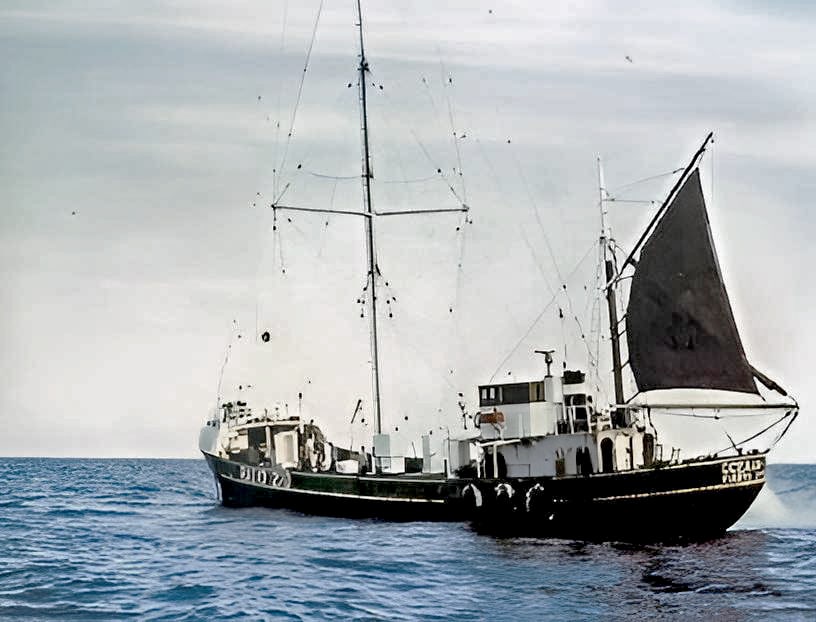Ship details: The Oceaan 7 was built in 1939 by A Vuijk and Zonen of Capelle, and was 139 feet long and 160 tons. The Ship was used by the Dutch fishing fleet of Scheveningen as “Scheveningen 333”. During World War II the Germans captured the ship and used her as a transportation vessel. After the war the ship was handed back to the Dutch fishing fleet where she was used until 1964. It was a sister ship of Radio Delmare’s Aegir II, of the ill-fated broadcasting vessel Morgenster and of the Dolfijn (used as a tender ship in the seventies).
In 1965 the vessel was purchased in Holland. The total cost price for the entire project was 75.000 pounds. This was incredibly low for a complete offshore radio station. The Oceaan 7 was registered in Puerto Rico (Honduras) and a true network of American and South American companies were established.
The engines were overhauled then the ship sailed to Guernsey where the aluminium mast was erected. The ship then sailed to Scarborough. On 26th February 1966 the Oceaan 7 arrived in Scarborough, and within hours conversion to a radio ship had began. Two studios were constructed, each had EMI tape decks, Spotmaster cartridge machines, Gerrard 401 turntables which were stabilised in gimbals. The studios were sound proofed and air conditioned. The output from the studio was then feed to the transmitter via a Pye limiter. A water distillery unit was installed on the ship, as well as a large oil burning stove. The wheelhouse was also fitted with radar and maritime radio. The galley was fitted with every modern appliance. Under the wheelhouse the ship´s four cylinder 240h.p. engine was run every evening after close down to ensure the ship´s capability of sailing under her own power. Two 40h.p. auxiliaries drove air compressors, pumps etc., including if necessary an emergency 5kW generator. Two 50 K.V.A. Dale Marine generators supplied all electricity. 6,000 gallons of oil were held in the main tank together with two reserves of 650 gallons each.
On 1st April the ship sailed to three miles off the Scarborough coast. At 09:00 hrs a force seven storm caused the 100 foot aluminium mast to swing violently, Dutch crew members cut the down the mast to prevent the ship from being damaged. The planned start up at midday had to be put off. The next day two local keel boats escorted the ship back to Scarborough. The rough weather continued for a few weeks and prevented the Oceaan 7 being towed to Grimsby for repairs. The bad and dangerous July weather forced the little fishing boat to take refuge in a harbour. On July 21st 1966, the Oceaan 7 arrived in the harbour of Bridleton for yet another repair on the transmitter mast and supplies. On October 28th 1966 there was panic among the members of the RADIO 270 organisation. An anonymous letter was received which said a bomb had been placed on board the vessel. Luckily, it turned out to be a prank.
On 3rd November 1966 a seized main shaft bearing forced the ship to be towed back to Scarborough by the tug Success II. Three days later Radio 270 returned to the air. In December the anchorage was changed to Bridlington, it was hoped that this would be a more sheltered position. On 4th August 1967 problems caused by jelly fish being sucked into the cooling water intake forced the station off the air and the ship changed anchorage. After the Marine Offences Act on 15th August 1967 at 15:30 the Oceaan 7 sailed to Whitby harbour under the control of Ken Lester. The broadcasting equipment and transmitting mast were removed from the ship. The ship was put up for sale by Tuckley and Company of Whitby and Scarborough for the sum of £25,000. In March 1968 the Ship nearly became temporary home for Radio Caroline, but the national press had leaked the story, The owners of the Oceaan 7 were threatened with prosecutions if broadcasts resumed form the Oceaan 7. Eventually The Oceaan 7 was sold as scrap for £5,000, and was broken up at Blyth, Northumberland.
Offshore radio station: Radio 270 from 4th June 1966 to 14th August 1967
Location: International waters off Scarborough and Bridlington (UK)

